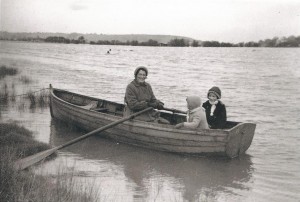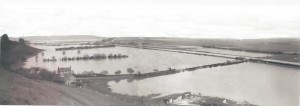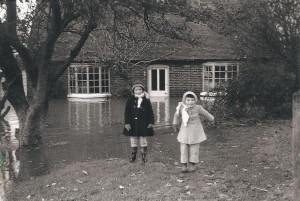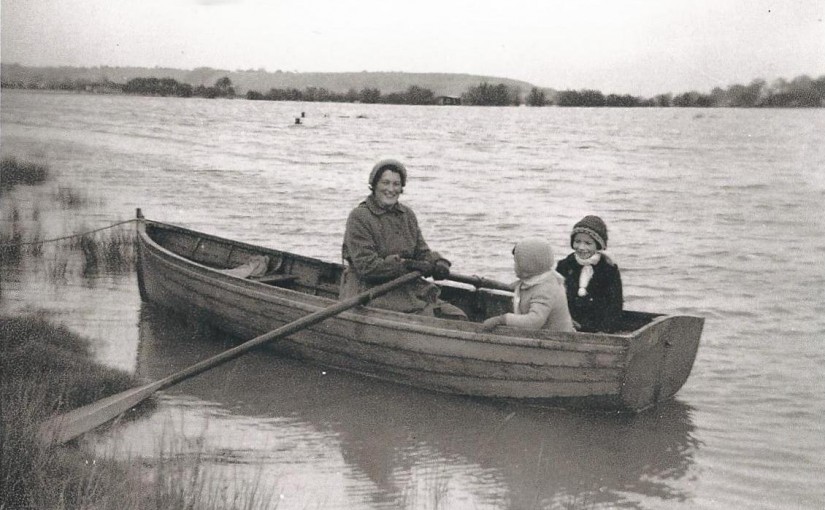By Beryl Dale
I went down to Rye with my daughter to discover more about the exceptional circumstances which had led to my parents’ house being flooded in November 1960.
I had been living in London at the time and had just completed the preliminary exams which took place half way through my Physiotherapy training. I was desperate to go home to unwind and relax. On the morning of that day I woke with a start to the strident ringing of the telephone. I had glanced at my watch as I stumbled out of bed 6.30am! My brain froze – who would be ringing at that hour unless something terrible had happened? I managed to lift the receiver more to stop the noise while I gathered my wits in order to speak. I must have said something as I realised it was my mother speaking to me. “Hello, I’m sorry you won’t be able to come home tonight as we have been flooded, with water coming into the house at each high tide. We have almost a foot of water in the kitchen and we have no heat or light. It’s a complete nightmare. We are living upstairs I am glad that you are not here to experience it. I will phone you tomorrow to let you know how we are coping.“
I responded by saying, “The only thing that has kept me going is the thought of coming home. I’ve booked my ticket and I will take pot luck and come anyway. I will only worry about you all if I stay in London, now that I know the situation”. “Well I wish you wouldn’t. The road between us and Scott’s Float is impassable.”
“Right, I will get as close as I can and I will bring my wellies.”
“Well as I can’t stop you I will phone Bryans Garage and ask for a taxi to meet you in the station approach this evening and I will ask for you to be dropped as close to the house as possible and where hopefully the water will be shallow. We will try to think of a way to transport you from the taxi to the house. Until tonight then. Wrap up well!”

Sure enough Mr Bannister, the taxi driver, was waiting for me. He knew nothing of the flood and felt that if there had been a problem in the morning it was probably OK by now. So we drove along the Military Road on the outskirts of Rye and at Scott’s Float, facing us, there was a sheet of deep black water. It was pitch-dark and yet I could make out the outline of my father in a rowing boat waiting to collect me! To this day I don’t know how he acquired the boat but we paid for the taxi and rowed home!
I learned that a friend who lived nearby had driven up from Boons Hill on a tractor to warn them of the flood. Then with great difficulty, the cooker and other electrical items were moved upstairs to protect them from the water. Other neighbours who had escaped the flood had brought hot food. There was a “war time” spirit around the event so I would like to learn more about the events which led up to what have been described as exceptional circumstances.

Before I laid plans for my visit I tried to find out more about the flood defences in the area – at that time they were managed by The Rother and Jury’s Gap Catchment Board.
Strangely and amazingly I could trace events around a storm which occurred in 1287 which changed the River Rother’s outlet to the sea from New Romney to Rye. I also learned the part played by the Royal Military Canal which starts at Seabrook and acts as a sink for the network of ditches that crisscross the marsh. During the summer when the rainfall is normally lower and water is needed to irrigate the land, water is pumped from the canal into the drainage ditches. In winter when there may be a risk of flood, water can be taken from the ditches into the canal and the excess water let out of the canal at Iden Lock or the sluice at Seabrook. This is a vital function of the canal and is presently managed by the Environment Agency.
The area affected at the time of the 1960 flood, started at Iden Lock where the canal joins the River Rother from the north. The lock has double gates on the lower side to stop excess water getting into the canal. The lock chamber is still intact and I learned that it is 72 feet by 16 feet however it was converted into a sluice in the 1960’s. The Military Road which runs from Appledore to Rye crosses the canal by way of a bridge at Iden Lock and on to what was then called Star Lock sluice. (In 1984 this was replaced by the Scott’s Float lock and sluice. Basically, it is a large lock gate which can open either way to control the passage of water depending on the state of the tide since at this point the river is tidal.) On the South-East side of Rye the River Brede runs into the River Rother which heads into its estuary and out to sea, while the canal heads west upstream on the River Brede.

So armed with some information, I contacted my Brother, my father’s cousin’s son and a friend of many years who had been living close to my home at the time. I wanted to know how it felt to go through the flood experience from their point of view. I rang The Windmill Guest House and arranged to stay overnight, giving us the opportunity visit our friends and family over a two day period.
We drove down the M25/M20 to Ashford and took the A2070 to Brenzett, and continued on a minor road to Appledore where we followed the Royal Military Canal to Rye. First we crossed the bridge at Iden Lock where the River Rother joins the canal from the North. Along the next stretch we passed what had been my parent’s house, giving no sign of the damage caused 52 years ago. Past what had been Star Lock and the first sight of the Scott’s Float Lock and Sluice which was built in 1984 and sited at Houghton Green. The sluice is a large lock gate which can open either way to control the passage of boats (and water) depending on the state of the tide. Beyond this point the river is tidal. We continued on into Rye went in search of the Windmill and then travelled to meet my brother and sister-in law at The Horse and Cart pub in Peasmarsh for lunch. This kind of research is very pleasant as we caught up with news of family now as well as “then”!
My brother recalled that our father had said that intensive rain caused so much water to flow off the land into the River Rother which was not so much of a problem when the tide was out but at high tide the water on the fresh water side of the Star lock gates built up and over-flowed. He said that the River Rother burst its banks at approximately Thornsdale, Iden. He woke up to the realisation that water was pouring into the house at an alarming rate. They rallied to move all the electrical appliances upstairs and moved his motor bike and the car to outside the flooded area. There was corn set to dry in sacks in the barn. They could do nothing to avoid the water drenching that area. There was a two foot cavity under the house which filled at high tide and the house flooded up to one foot. This dropped when the tide allowed the gates to open again. He remembered the rowing boat but did not know how we had acquired it. He said that they all had had flu which they must have largely recovered from as I just remember us rowing around and revelling in this newly created water environment, while my mother had to deal with all the problems of devastation later.
Next we visited my father’s cousin’s son. He and his wife had invited a friend to join us there and it transpired that he had driven up to our house on a tractor, in the early hours to warn my parents about the flood. He had many photos of the event and showed them to me on the following day and has since sent me copies. I learned from my host that although he didn’t know how my father had acquired the boat, he knew he had needed to resort to row it with a spade until he managed track down some oars!
It was all so interesting and after a most pleasant stay at the Windmill we spend most of the next day at our friends’ home, catching up, pouring over photos and trying not to think of our return journey up the M25!
Rye’s Own December 2012
All articles, photographs and drawings on this web site are World Copyright Protected. No reproduction for publication without prior arrangement. © World Copyright 2015 Cinque Ports Magazines Rye Ltd., Guinea Hall Lodge Sellindge TN25 6EG
